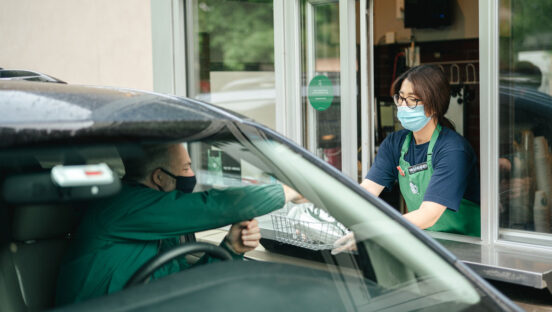The COVID-19 pandemic has changed our daily routines profoundly in countless ways, but none may be more universal than the rapid adaptation of quick-service restaurants to drive-thru-centric service models. Acting as a virtual lifeline to restaurants from the onset of this pandemic, the drive-thru has now become an obvious visual signifier of the times we live in.
In this age of social distancing, the shift of focus away from the on-premise dining room may alter customer preferences well beyond the current period. For these restaurants to flourish in both normal and uncertain conditions, their experience must be a paragon of technology-enabled flexibility, efficiency and customer safety.
Customers Need a Special (No) Touch
A key step to establishing a “new normal” going forward will be restoring confidence in their safety as they transact businesses in both quick-service drive-thrus and newly reopened dining rooms without compromising buying incentives such as coupons and gift cards. Even though drive-thru options and touchless payments can greatly reduce contact, there is still an exchange when customers want to use buying incentives. Restaurateurs are pivoting to some innovative solutions to answer this challenge.
One tool at their disposal is enabling strong secondary scanning devices. With secondary scanning solution, the customer can simply hold out their personal smart devices displaying barcodes/digital coupons and the drive-thru cashier can use the barcode scanner to read the presented information without touching. This allows the customer and drive-thru cashier to minimize contact. Without a secondary scanner, the employee would be forced to take the coupon or personal item and either hand-key or conduct an additional scan into the system leading to increased touch and wait times. Even more importantly, secondary scanning devices can easily be tethered to either drive-thru windows or the actual cashier processing the order. This way, you can put to rest any worries of butterfingered associates dropping your brand-new devices out on an unforgiving pavement during a busy rush.
This emphasis on safe, contactless operation is moving to inside the dining room as well. One cherished feature of quick-serves—the self-service beverage dispenser—is quickly evolving to the no-touch paradigm as well. Leading soft-drink manufacturers have enabled QR-based technology on their flagship dispensers in order to allow customers to order their favorite drinks on-demand without physically interacting with the equipment in any way. They can hold their personal smartphone camera to the dispenser’s display to scan the QR code. Once scanned, it replicates the dispenser’s user interface on their screen. That makes it intuitive, safe and seamless for them to choose from the full menu of brands and flavors on offer. The dispenser does the rest, then offers a full cup of the customer’s choice beverage for them to pickup.
Smarter integration with customers’ personal devices will be a key component of managing lines, safety and customer expectations going forward.
Safety Meets State-of-the-Art
While contactless ordering, pickup and transactions will be crucial components going forward, customers will stay want to occupy and use dining rooms as states gradually phase in dining room reopenings. Quick-service restaurant operators are tasked with providing the cleanest possible environments in both their dining rooms and kitchens in order to reduce the spread of harmful viruses. Manual cleaning, no matter how extensive and regularly-done, will leave operators at some level of risk. This is why tech-based ultraviolet light cleaning solutions have become an attractive proposition.
UV-C light is used to eradicate harmful bacteria, including antibiotic resistant viruses (including Coronaviruses SARS and MERS). Best of all, you don’t have to rely strictly upon cleaning service providers to do periodic UV-C light “deep cleanings” while you are closed. Quick-serve operators can now employ a host of smartphone, tablet, payment pad and kiosk enclosures that employ UV-C light to offer a continuous, automated disinfection of high-touch surfaces to greatly reduce to spread of dangerous microbes.
As for kitchen operations, the importance of ensuring that your employees are in full compliance with federal and state food handling and prep guidelines can’t be overstated. Even before large-scale health-related events such as the COVID-19 pandemic, food labeling and traceability were areas of paramount concern and great liability for operations.
This allows employees to be more aware of shelf life calculations and reduce the chances of serving your customers spoiled food. It also promotes standardized, consistent labeling throughout all your locations for a more streamlined experience. To this end, operators are now employing tablets paired with mobile thermal printers to proactively track inventory and avoid spoilage/food waste. They can also simplify food prep with convenient batch label printing. Best of all, this mobile technology generates data to inform valuable insights on kitchen operations.
In the age of social distancing, restaurants must evolve to ensure business continuity and profitability. Leveraging technology in a smart, safe and efficient fashion will be the difference maker in this challenging business environment and beyond. Quick-service restaurant brands must quickly ascertain if they have sufficient in-house expertise and resources to rise to the occasion, and then engage leading technology partners to fill in the gaps where they don’t.
It’s “essential” to their survival.
Micah Robinson is the Content Marketing Manager at Stratix. He has more than 20 years of experience in enterprise content strategy and creation. Micah brings extensive experience overseeing technical thought leadership and communications regarding enterprise mobility for both large-scale businesses and small software startups. He specializes in creating detailed strategies and content bundles that offer guidance via crucial industry insights and trend analysis.











